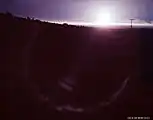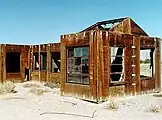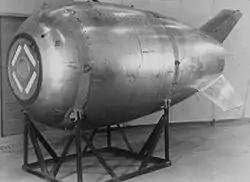Operation Ranger
Operation Ranger was the fourth American nuclear test series. It was conducted in 1951 and was the first series to be carried out at the Nevada Test Site.[1] All the bombs were dropped by B-50D bombers and exploded in the open air over Frenchman Flat (Area 5).
| Operation Ranger | |
|---|---|
 Ranger Able, 1 kiloton. | |
| Information | |
| Country | United States |
| Test site | NTS Areas 5, 11, Frenchman Flat |
| Period | 1951 |
| Number of tests | 5 |
| Test type | free air drop |
| Max. yield | 22 kilotonnes of TNT (92 TJ) |
| Test series chronology | |
These tests centered on the practicality of developing a second generation of nuclear weapons using smaller amounts of valuable nuclear materials. They were planned under the name Operation Faust.
The exact locations of the tests are unknown, as they were all air drops. However, the planned ground zero was set at 36°49′32″N 115°57′54″W[2] for all except the Fox shot, which was "500 feet [150 m] west and 300 feet [91 m] south" in order to minimize damage to the control point.[3]
| Name [note 1] | Date time (UT) | Local time zone[note 2][4] | Location[note 3] | Elevation + height [note 4] | Delivery,[note 5] Purpose [note 6] | Device[note 7] | Yield[note 8] | Fallout[note 9] | References | Notes |
|---|---|---|---|---|---|---|---|---|---|---|
| Able | January 27, 1951 13:44:51.0 | PST (–8 hrs) | NTS Area 5 ~ 36.82664°N 115.95883°W | 1,010 m (3,310 ft) + 323 m (1,060 ft) | free air drop, weapons development | Mk-4, Type D | 1 kt | I-131 venting detected, 1.3 MCi (48 PBq) | [5][6][7][8][9][10] | First test over continental United States since Trinity. Testing compression against critical mass as inspired by the demon core. Often later used for a 1 kt calibrated explosion. See also Ranger Easy. |
| Baker 1 | January 28, 1951 13:52:04.5 | PST (–8 hrs) | NTS Area 5 ~ 36.82664°N 115.95883°W | 1,010 m (3,310 ft) + 329 m (1,079 ft) | free air drop, weapons development | Mk-4, Type D, TOM Init | 8 kt | I-131 venting detected, 3.2 MCi (120 PBq) | [5][6][7][8][9][10] | Fractional critical core, TOM initiator. See also Ranger Easy. |
| Easy | February 1, 1951 13:46:39.5 | PST (–8 hrs) | NTS Area 5 ~ 36.82664°N 115.95883°W | 1,010 m (3,310 ft) + 329 m (1,079 ft) | free air drop, weapons development | Mk-4, Type D | 1 kt | [5][6][7][8][9][10] | Testing compression against critical mass. | |
| Baker 2 | February 2, 1951 13:48:48.0 | PST (–8 hrs) | NTS Area 5 ~ 36.82664°N 115.95883°W | 1,010 m (3,310 ft) + 335 m (1,099 ft) | free air drop, weapons development | Mk-4, Type D | 8 kt | [5][6][7][8][9][10] | Identical to Ranger Baker 1, test of reproducible results. See also Ranger Easy. | |
| Fox | February 6, 1951 13:46:55.0 | PST (–8 hrs) | NTS Area 5 36.82485°N 115.96708°W | 1,010 m (3,310 ft) + 437 m (1,434 ft) | free air drop, weapons development | Mk-6 HOW, Type D "Freddy" | 22 kt | [5][6][7][8][9][10] | Proof Test of Mark 6 HOW "Fox" core. "500 ft west and 300 ft south of drop target used by other Ranger blasts, to avoid damage to the control point.". |
- The US, France and Great Britain have code-named their test events, while the USSR and China did not, and therefore have only test numbers (with some exceptions – Soviet peaceful explosions were named). Word translations into English in parentheses unless the name is a proper noun. A dash followed by a number indicates a member of a salvo event. The US also sometimes named the individual explosions in such a salvo test, which results in "name1 – 1(with name2)". If test is canceled or aborted, then the row data like date and location discloses the intended plans, where known.
- To convert the UT time into standard local, add the number of hours in parentheses to the UT time; for local daylight saving time, add one additional hour. If the result is earlier than 00:00, add 24 hours and subtract 1 from the day; if it is 24:00 or later, subtract 24 hours and add 1 to the day. Historical time zone data obtained from the IANA time zone database.
- Rough place name and a latitude/longitude reference; for rocket-carried tests, the launch location is specified before the detonation location, if known. Some locations are extremely accurate; others (like airdrops and space blasts) may be quite inaccurate. "~" indicates a likely pro-forma rough location, shared with other tests in that same area.
- Elevation is the ground level at the point directly below the explosion relative to sea level; height is the additional distance added or subtracted by tower, balloon, shaft, tunnel, air drop or other contrivance. For rocket bursts the ground level is "N/A". In some cases it is not clear if the height is absolute or relative to ground, for example, Plumbbob/John. No number or units indicates the value is unknown, while "0" means zero. Sorting on this column is by elevation and height added together.
- Atmospheric, airdrop, balloon, gun, cruise missile, rocket, surface, tower, and barge are all disallowed by the Partial Nuclear Test Ban Treaty. Sealed shaft and tunnel are underground, and remained useful under the PTBT. Intentional cratering tests are borderline; they occurred under the treaty, were sometimes protested, and generally overlooked if the test was declared to be a peaceful use.
- Include weapons development, weapon effects, safety test, transport safety test, war, science, joint verification and industrial/peaceful, which may be further broken down.
- Designations for test items where known, "?" indicates some uncertainty about the preceding value, nicknames for particular devices in quotes. This category of information is often not officially disclosed.
- Estimated energy yield in tons, kilotons, and megatons. A ton of TNT equivalent is defined as 4.184 gigajoules (1 gigacalorie).
- Radioactive emission to the atmosphere aside from prompt neutrons, where known. The measured species is only iodine-131 if mentioned, otherwise it is all species. No entry means unknown, probably none if underground and "all" if not; otherwise notation for whether measured on the site only or off the site, where known, and the measured amount of radioactivity released.
Gallery
 Ranger Able, 1 kiloton
Ranger Able, 1 kiloton.jpg.webp) Ranger Baker 1, 8 kilotons
Ranger Baker 1, 8 kilotons.jpg.webp) Ranger Fox, 22 kilotons.
Ranger Fox, 22 kilotons. "Glass-House" structure built to determine blast effects on glazing and window construction, and to assess the problem of flying glass, test Ranger-Easy.
"Glass-House" structure built to determine blast effects on glazing and window construction, and to assess the problem of flying glass, test Ranger-Easy. Mark 4 device as detonated in all Ranger tests, excluding test Fox.
Mark 4 device as detonated in all Ranger tests, excluding test Fox.
References
- Hacker, Barton C (1994). Elements of Controversy: The Atomic Energy Commission and Radiation Safety in Nuclear Weapons Testing 1947-1974. University of California Press. p. 44. ISBN 0-520-08323-7. Retrieved January 3, 2012.
- Maag, Carl; Rohrer, Stephen; Shepanek, Robert (February 26, 1982). Operation Ranger: Shots Able, Baker, Easy, Baker-2, Fox (PDF) (Report). Defense Nuclear Agency. DNA-6022F. Archived from the original on April 9, 2013. Retrieved March 5, 2013.
- Fehner, Terrence R.; Gosling, F. G. (2000). Origins of the Nevada Test Site (PDF) (Report). Department of Energy. DOE.MA-0158. Retrieved March 5, 2013.
- "Time Zone Historical Database". iana.com. Retrieved March 8, 2014.
- Operation Ranger: Shots Able, Baker, Easy, Baker-2, Fox, 25 January-6 February 1951 (DNA-6022F), Washington, DC: Defense Nuclear Agency, 1982, retrieved January 6, 2014
- Estimated exposures and thyroid doses received by the American people from Iodine-131 in fallout following Nevada atmospheric nuclear bomb tests, Chapter 2 (PDF), National Cancer Institute, 1997, retrieved January 5, 2014
- Sublette, Carey, Nuclear Weapons Archive, retrieved January 6, 2014
- Hansen, Chuck (1995), The Swords of Armageddon, Vol. 8, Sunnyvale, CA: Chukelea Publications, ISBN 978-0-9791915-1-0
- United States Nuclear Tests: July 1945 through September 1992 (PDF) (DOE/NV-209 REV15), Las Vegas, NV: Department of Energy, Nevada Operations Office, December 1, 2000, archived from the original (PDF) on October 12, 2006, retrieved December 18, 2013
- Yang, Xiaoping; North, Robert; Romney, Carl (August 2000), CMR Nuclear Explosion Database (Revision 3), SMDC Monitoring Research
- Griggs, D. T.; Frank Press (1961). "Probing the earth with nuclear explosions". Journal of Geophysical Research. 66 (1): 237–258. Bibcode:1961JGR....66..237G. doi:10.1029/jz066i001p00237. hdl:2027/mdp.39015077588872.
External links
- The short film Nuclear Test Film – Operation Ranger, Operation Buster/Jangle (1951) is available for free viewing and download at the Internet Archive.
Wikimedia Commons has media related to Operation Ranger.
This article is issued from Wikipedia. The text is licensed under Creative Commons - Attribution - Sharealike. Additional terms may apply for the media files.